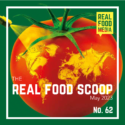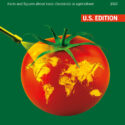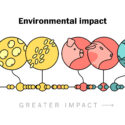by Anna Lappé
This past weekend, biotech giant Monsanto paid bloggers $150 each to attend “an intimate and interactive panel” with “two female farmers and a team from Monsanto.” The strictly invitation-only three-hour brunch, which took place on the heels of the BlogHer Conference, promised bloggers a chance to learn about “where your food comes from” and to hear about the “impact growing food has on the environment, and how farmers are using fewer resources to feed a growing population.” Though the invitation from BlogHer explicitly stated, “No blog posts or social media posts expected,” the event was clearly designed to influence the opinions — and the writing — of a key influencer: the mommy blogger. Another invite-only event in August will bring bloggers to a Monsanto facility in Northern California for a tour of its fields and research labs. Again, while no media coverage is expected, the unspoken goal is clear.
Stealth marketing techniques, such as these by Monsanto, reveal how the food industry — from biotech behemoths to fast-food peddlers — is working surreptitiously to shape public opinion about biotechnology, industrialized farming and junk food.
We’ve come a long way from Don Draper’s whisky-infused ad concepts meant for old-style print publications. As our media landscape has changed, Big Ag has changed along with it, devising marketing to take advantage of this new terrain and influence the people and platforms — not just journalists and newspapers — that shape our understanding of farming and the health impacts of biotechnology and junk food.
Sean Timberlake, who has been blogging for nearly a decade, characterized industry’s move into the social media space as “sweeping and vast.” He explained that back when he started out, “I don’t think the Monsantos of the world understood what blogs were — or cared,” but now, “companies develop entire budget lines for social media programs. They build it into their whole ad budget.” Ad networks such as BlogHer and Federated — two of the biggest — facilitate companies’ advertising and outreach on blogs by aggregating blogs to sell as a bigger package. These networks, Timberlake explained, “can be leveraged and used as a bullhorn for their marketing.”
Sure, PR is an old game, but Big Ag is giving the age-old techniques of shaping public opinion a new, sneakier spin. Much of today’s marketing happens behind the scenes and off the printed page — on the Web pages of blogs, on Twitter feeds and Facebook pages, through sponsored content and industry-funded webisodes and on the stages of big-ideas festivals.
Monsanto is not the only food company engaging with the blogosphere. Mommy bloggers are the food industry’s newest nontraditional ally. McDonald’s has been wooing them aggressively too, offering sweepstakes in partnership with BlogHer for the company’s Listening Tour Luncheon, an exclusive event with the head of McDonald’s USA — framed as a two-way conversation about nutrition, but more likely a gambit to garner the support of a powerful group of influencers. And in Canada, McDonald’s offers All-Access Mom, behind-the-scenes tours of the company’s inner workings.
It’s not just through blogger meet-and-greets that industry is attempting to sway opinion. Video is an increasingly popular (and shareable) medium for PR disguised as content. This summer, for example, Monsanto is funding a Condé Nast Media Group film series called “A Seat at the Table.” According to a casting call, each three- to five-minute episode will cover questions such as “Are food labels too complicated?” and “GMOs: good or bad?” and will feature “an eclectic mix of industry and nonindustry notables with diverse viewpoints.” It’s hard to imagine truly free-flowing discussions resulting, paid for as they are by a company with a definitive take on — and stake in — the food-labeling wars. The U.S. Farmers and Ranchers Alliance, meanwhile, funded the documentary “Farmland,” described as a “look at the lives of farmers and ranchers,” but whose narrative — as critics have been quick to point out — “glorif[ies] the trend toward larger, more industrialized farms.” No surprise, given that the film’s financing comes from an agribusiness front group.
Big Ag is putting its communications dollars toward big-ideas events too, such as the Aspen Ideas Festival, where underwriters such as Monsanto are celebrated — and get a voice. Monsanto executives got to share their opinions onstage about GMO labeling (surprise: they’re not in favor of state-based labeling initiatives) and how best to feed the world (again: their chemicals and genetically engineered seeds are key to combating hunger). And past years have seen Coca-Cola, DuPont and Syngenta executives all touting their companies’ sustainability onstage.
The uptick in these stealth-marketing strategies coincides with growing popular outcry about agricultural chemicals, soda and junk food and genetically modified ingredients. Consider that despite millions spent on marketing over the two decades since genetically engineered seeds were first commercialized, 93 percent of Americans still think GMOs should be labeled and 65 percent are either unsure about the technology or believe it to be unsafe. Last year, when Monsanto retained the PR firm FleishmanHillard, known for its work with social media and agribusiness, to develop its new marketing initiatives, it did so “amid fierce opposition to the seed giant’s genetically modified products,” noted the Holmes Report, a PR industry publication.
The father of public relations, Edward Bernays, might never have dreamed up the age of Twitter and Facebook, but he likely wouldn’t be surprised to see food-industry tweets and Facebook ads dressed up as news. Bernays knew the importance of constant PR innovation. If the public “becomes weary of the old methods used to persuade it,” he wrote in his 1928 book “Propaganda,” then we must simply present our “appeals more intelligently.” Or, as we’re seeing with Monsanto and its food industry counterparts, if not exactly intelligently, then at least more surreptitiously: on the podium, the Twitter feeds and the mommy blogs.
Originally published in Al Jazeera America
Photo by Steve Jennings/Getty Images for McDonald’s via Al Jazeera America




